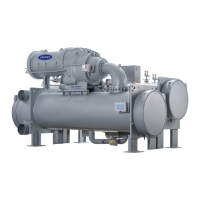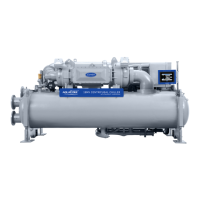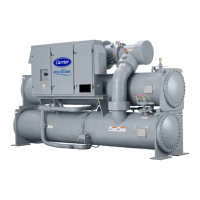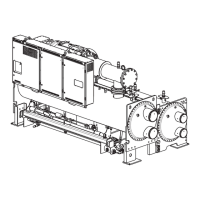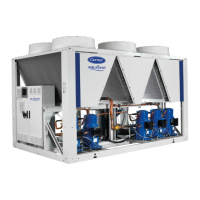94
Inspect Variable Frequency Drive — Perform the
following variable frequency drive inspections annually:
• Inspect the cooling fan.
• Clean the power module and cabinet (vacuum clean).
• Check and tighten electrical connections as needed.
• Perform visual inspection and capacitor test of the filter sec-
tion of the VFD.
• Perform visual inspection of the inductors for overheating
or other signs of deterioration. If yes, isolate and check for
voltage leak.
• Test to ground (line and link reactors if applicable).
• Inspect, clean, and test harmonic filter (if applicable).
• Review and record the alarm history of the starter.
• Check drive configurations for accuracy.
• Verify that the variable frequency drive installed location is
in an ambient temperature range and humidity (non-con-
densing) within its design values and altitude level.
• Verify that the variable speed drive throughout the year is in
a clean, ventilated location.
• Verify the power supply for the VFD does not include
power factor correction capacitors.
• Do not try to maintain chiller operation through an open
power transfer from secondary power supplies.
• Verify that the variable speed drive is not subject to dirty
electrical power, spikes, low voltage, sags, or other electri-
cal power abnormalities.
Inspect Relief Valves and Piping — The relief
valves on this chiller protect the system against the potentially
dangerous effects of overpressure. To ensure against damage to
the equipment and possible injury to personnel, these devices
must be kept in peak operating condit ion. Inspect the relief
valves in accordance with local codes.
At a minimum, the following maintenance is required.
1. At least once a year, disconnect the vent piping at the
valve outlet and carefully inspect the valve body and
mechanism for any evidence of internal corrosion or rust,
dirt, scale, leakage, etc.
2. If corrosion or foreign material is found, do not attempt to
repair or recondition. Replace the valve.
3. If the chiller is installed in a corrosive atmosphere or the
relief valves are vented into a corrosive atmosphere,
make valve inspections at more frequent intervals.
Compressor Bearing Maintenance — The com-
pressor bearings are designed to last for the life of the chiller.
The key to good bearing maintenance is proper lubrication.
Use the proper grade of oil, maintained at recommended level,
temperature, and pressure. Inspect the lubrication system
regularly and thoroughly.
Excessive bearing wear can be detected through increased
vibration. Carrier recommends that periodic vibration analysis
be performed as part of compressor preventative maintenance
program. For Optional Extended Warranty, consult the warran-
ty’s specific requirements. Contact an experienced and respon-
sible service organization to perform vibration analysis on the
compressor.
Compressor Rotor Check — Use Carrier specified
oil. Excessive compressor rotor wear is shown by a lack of
performance. If a lack of performance is noted, have the
compressor rotors inspected by a trained service person.
The rotors can be visually inspected once every 5 to
10 years or as needed depending on chiller operating
conditions.
Motor Insulation — Periodic checks of the motor insula-
tion are recommended. (For Optional Extended Warranty,
consult the warranty’s specific requirements.) A 500-v meg-
ohmmeter test is recommended to assist troubleshooting if
there are indications of problems including, but not limited to,
moisture in the refrigerant, and chronic current imbalance or
over current trips. See guidelines for megohmmeter test in the
Before Initial Start-Up, Ground Fault Troubleshooting section
on page 74.
Inspect the Heat Exchanger Tubes
COOLER — Inspect and clean the cooler tubes at the end of
the first operating season. Because these tubes have internal
ridges, a rotary-type tube cleaning system is necessary to fully
clean the tubes. Upon inspection, the tube condition will deter-
mine the scheduled frequency for cleaning, and will indicate
whether liquid treatment is adequate in the chilled liquid/
brine circuit. Inspect the entering and leaving chilled liquid
temperature sensors for signs of corrosion or scale. Replace the
sensor if corroded or remove any scale if found.
CONDENSER — Since this liquid circuit is usually an open-
type system, the tubes may be subject to contamination and
scale. Clean the condenser tubes with a rotary tube cleaning
system at least once per year and more often if the liquid is
contaminated. Inspect the entering and leaving condenser liq-
uid sensors for signs of corrosion or scale. Replace the sensor if
corroded or remove any scale if found.
Higher than normal condenser pressures, together with the
inability to reach full refrigeration load, usually indicate dirty
tubes or air in the chiller. If the refrigeration log indicates a rise
above normal condenser pressures, check the condenser refrig-
erant temperature against the leaving condenser liquid tem-
perature. If this reading is more than what the design difference
is supposed to be, then the condenser tubes may be dirty or liq-
uid flow may be incorrect. Because HFC-134a is a high-pres-
sure refrigerant, air usually does not enter the chiller.
During the tube cleaning process, use brushes especially
designed to avoid scraping and scratching the tube wall.
Contact your Carrier representative to obtain these brushes. Do
not use wire brushes.
Water/Brine Leaks — Moisture in the refrigerant is in-
dicated during chiller operation by the refrigerant moisture
indicator on the refrigerant motor cooling line. See Fig. 2-4.
Leaks should be repaired immediately.
CAUTION
The motor leads must be disconnected from the VFD
before an insulation test is performed. The voltage gener-
ated from the test equipment can damage the solid-state
VFD components.
CAUTION
Hard scale may require chemical treatment for its preven-
tion or removal. Consult a liquid treatment specialist for
proper treatment. Failure to properly treat liquid could
result in property damage or personal injury.
CAUTION
The chiller must be dehydrated after repair of liquid leaks.
See Chiller Dehydration section, page 71. Failure to dehy-
drate the chiller after repair of liquid leaks could result in
equipment damage or personal injury.

